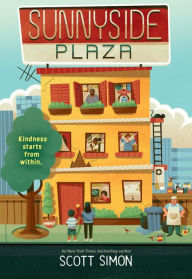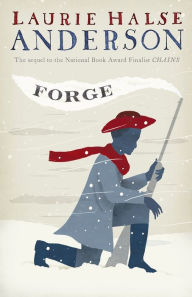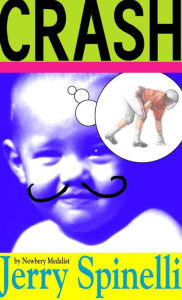The Books We Read as Youngsters Stay with Us: A Guest Post by Scott Simon, Author of Sunnyside Plaza

Sunnyside Plaza
Sunnyside Plaza
By Scott Simon
In Stock Online
Hardcover $16.99
“Believe me,” I’ve always told my daughters, Elise and Paulina. “The Old Man and the Sea. The Diary of Anne Frank. Those books still bounce in my head. New novels I read last week? I’m already a little sketchy. When we’re young, we pack our minds and hearts for the long trip.”
A while ago, I mused for the umpteenth occasion over family dinner about the time I’d spent as a young man, working in a home in Chicago for adults with developmental disabilities.
“First day I walked in,” I’d often told our daughters, “you see people at a folding table, finger-painting. If they were kids, you’d say things I’ve always said about your art. ‘Hey, lookee here, another Picasso! Jackson Pollack!’ But when it’s a fifty-year-old man or woman doing the finger-painting you think, ‘Oh, how sad.’ By the third or fourth day, you’re over your pity. You see them as people. You get to know their humor, talents, the courage it takes to get through the day. I never learned more in my life. Someday, I want to write a novel set in a place like that.”
“You should make it for kids our age,” our oldest daughter, Elise, finally said one night. “So we’ll remember it, like you always say kids do.”
Our daughters threw my writer’s hat over the wall. I had to follow.
“Believe me,” I’ve always told my daughters, Elise and Paulina. “The Old Man and the Sea. The Diary of Anne Frank. Those books still bounce in my head. New novels I read last week? I’m already a little sketchy. When we’re young, we pack our minds and hearts for the long trip.”
A while ago, I mused for the umpteenth occasion over family dinner about the time I’d spent as a young man, working in a home in Chicago for adults with developmental disabilities.
“First day I walked in,” I’d often told our daughters, “you see people at a folding table, finger-painting. If they were kids, you’d say things I’ve always said about your art. ‘Hey, lookee here, another Picasso! Jackson Pollack!’ But when it’s a fifty-year-old man or woman doing the finger-painting you think, ‘Oh, how sad.’ By the third or fourth day, you’re over your pity. You see them as people. You get to know their humor, talents, the courage it takes to get through the day. I never learned more in my life. Someday, I want to write a novel set in a place like that.”
“You should make it for kids our age,” our oldest daughter, Elise, finally said one night. “So we’ll remember it, like you always say kids do.”
Our daughters threw my writer’s hat over the wall. I had to follow.
Forge (Seeds of America Trilogy Series #2)
Forge (Seeds of America Trilogy Series #2)
In Stock Online
Paperback $8.99
I had never written a novel for young readers. But I had loved novels by Jerry Spinelli, Laurie Halse Anderson, Jarrett J. Krosoczka, R.J. Palacio, Jenny Han, Stacy McAnulty, and many others along with our daughters. I had seen how Elise and Paulina immersed themselves into those great books. I wanted a story set in the kind of home in which I’d worked, among people inspired by the ones I had known and hoped it might sink into young readers today.
I asked Elise, who was then fifteen, and her friend, Adelaide, to be my first readers. Their reactions were crucial. I knew as I began to write Sunnyside Plaza that I would break one of the first “rules” of literature for young readers. The narrator of the story is a nineteen-year-old woman, not a child. Sally Miyake, or Sal Gal, lives in a home for adults with developmental disabilities.
I knew from our own family how young readers could empathize with someone who had altogether different lives from their own. Our daughters had loved characters like Curzon of Laurie Halse Anderson’s Forge, of a different race and time, and Jerry Spinelli’s Crash, of a different place and personality. But wise editors advised that the central characters in stories for young readers usually, kind of, always had to be a young person, too.
Yet it was important to me to at least try to ask young readers to connect with Sal Gal through her own heart and mind. I didn’t want to concoct some “adolescent savior” character to guide and learn from Sal Gal. I wanted Sal and her friends in Sunnyside Plaza to entertain and enthrall readers with their own ingenuity.
I had never written a novel for young readers. But I had loved novels by Jerry Spinelli, Laurie Halse Anderson, Jarrett J. Krosoczka, R.J. Palacio, Jenny Han, Stacy McAnulty, and many others along with our daughters. I had seen how Elise and Paulina immersed themselves into those great books. I wanted a story set in the kind of home in which I’d worked, among people inspired by the ones I had known and hoped it might sink into young readers today.
I asked Elise, who was then fifteen, and her friend, Adelaide, to be my first readers. Their reactions were crucial. I knew as I began to write Sunnyside Plaza that I would break one of the first “rules” of literature for young readers. The narrator of the story is a nineteen-year-old woman, not a child. Sally Miyake, or Sal Gal, lives in a home for adults with developmental disabilities.
I knew from our own family how young readers could empathize with someone who had altogether different lives from their own. Our daughters had loved characters like Curzon of Laurie Halse Anderson’s Forge, of a different race and time, and Jerry Spinelli’s Crash, of a different place and personality. But wise editors advised that the central characters in stories for young readers usually, kind of, always had to be a young person, too.
Yet it was important to me to at least try to ask young readers to connect with Sal Gal through her own heart and mind. I didn’t want to concoct some “adolescent savior” character to guide and learn from Sal Gal. I wanted Sal and her friends in Sunnyside Plaza to entertain and enthrall readers with their own ingenuity.
Crash
Crash
In Stock Online
Paperback $10.99
I wrote about three-quarters of a first draft. Elise and Adelaide said they liked it. They got a lot of the jokes made by Sal and her friends. They noticed errors in continuity—the shirt that’s blue in chapter three that’s green in chapter six, and that I had given two characters the same name. They suggested a contemporary adolescent profanity to replace the one I had used. They guessed about who might prove to be culprits in the story and told me, “Try not to make your book any longer than The Old Man and the Sea.”
This is sound advice for any novelist.
And most of all, Elise and Adelaide registered no surprise or disappointment that Sal Gal wasn’t their age.
“She’s really interesting,” they told me. “You wonder what she’ll do.”
I finished my first draft of Sunnyside Plaza and sent it to my young critics. But I included something to read in comparison; three chapters of an “alternative” Sunnyside, in which I made the narrator a fourteen-year old girl who meets Sal Gal.
I asked Elise and Adelaide which storytelling voice they found most engaging. Within two days they delivered their judgment, writing me from school between classes: “Sal’s point of view is more intriguing. Her point of view is very unique.”
Who says “unique” shouldn’t be modified? I think their use of the phrase is very uniquely brilliant.
Our daughters and their friend encouraged me to have Sally Miyake tell her own story in Sunnyside Plaza. Elise, Paulina, and Adelaide helped me have faith that Sal Gal’s unique voice could work its way into the hearts of young readers.
I wrote about three-quarters of a first draft. Elise and Adelaide said they liked it. They got a lot of the jokes made by Sal and her friends. They noticed errors in continuity—the shirt that’s blue in chapter three that’s green in chapter six, and that I had given two characters the same name. They suggested a contemporary adolescent profanity to replace the one I had used. They guessed about who might prove to be culprits in the story and told me, “Try not to make your book any longer than The Old Man and the Sea.”
This is sound advice for any novelist.
And most of all, Elise and Adelaide registered no surprise or disappointment that Sal Gal wasn’t their age.
“She’s really interesting,” they told me. “You wonder what she’ll do.”
I finished my first draft of Sunnyside Plaza and sent it to my young critics. But I included something to read in comparison; three chapters of an “alternative” Sunnyside, in which I made the narrator a fourteen-year old girl who meets Sal Gal.
I asked Elise and Adelaide which storytelling voice they found most engaging. Within two days they delivered their judgment, writing me from school between classes: “Sal’s point of view is more intriguing. Her point of view is very unique.”
Who says “unique” shouldn’t be modified? I think their use of the phrase is very uniquely brilliant.
Our daughters and their friend encouraged me to have Sally Miyake tell her own story in Sunnyside Plaza. Elise, Paulina, and Adelaide helped me have faith that Sal Gal’s unique voice could work its way into the hearts of young readers.


